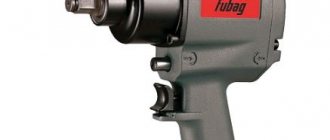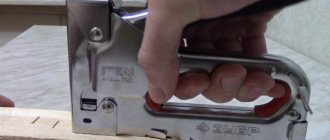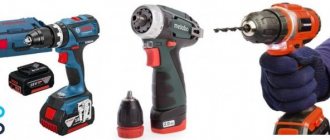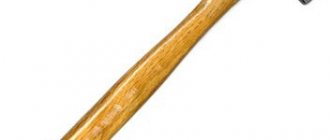A hammer is a striking tool used to drive nails by converting kinetic energy into mechanical energy. The history of the appearance of the instrument goes back several thousand years, but its relevance is not lost even today. No repair or large-scale construction can be completed without this device. Electric or pneumatic analogues cannot replace a simple version of the hammer device. There are several types of tools, each of which can perform other functions in addition to driving. Each type must meet certain GOST requirements.
Characteristics and purpose of the tool
To understand the characteristics of a tool, you must first determine what the hammer is intended for. This device is used if you need to drive a nail or a metal wedge. But the striker device can be more functional, for example, equipped with a device for pulling out nails. This hammer for removing nails is called a nail puller. There are other species that also have their own names.
As for the simplest option, the standard hammer complies with GOST 2310-77. The weight of the hammer depends on the functional features and scope of application, but usually it does not exceed 4 kg. To become more familiar with the tool, it is worth knowing its characteristics. But first you need to know the structure of the device.
GOST 2310-77 Steel hammers. Specifications
1 file 483.81 KB
Looking at the tool, it immediately becomes clear what the hammer consists of:
- Head. The metal part, which in turn is divided into a firing pin, a wedge and a sharp toe, can also have different shapes. Typically the hammer head has a round head and a spherical toe.
- Lever. The length of the handle consists of a part on which the manufacturer’s logo is applied and the main part for holding. The length of the hammer handle can be different, the main thing is that it provides a normal grip.
The dimensions of the hammer are determined in accordance with the structure and type. The main relationship is the mass of the head and the length of the tool handle. The average length can be from 25 cm to 33 cm. Otherwise, if the metal part is heavy and the handle is short, the device will quickly break or be ineffective.
Characteristics of the hammer according to its components:
- The weight of a hammer for driving nails can be 300-800 g. It can be more than 1 kg if the entire structure is made of metal.
- The tool head is always made of steel. Hammer steel goes through several stages of processing - casting, hardening, forging. The protective layer of solid material is 3-4 mm.
- To prevent the metal from being “eaten up” by corrosion, it is covered with a protective layer. Thanks to this, the striking part of the hammer can withstand enormous pressure and powerful blows.
A low-quality firing pin can be immediately identified by its coating. If the head is painted, then the metal is not made according to GOST requirements, and, therefore, is of poor quality.
The handle of any type of hammer can be made of wood, metal or fiberglass. All presented options have their advantages and disadvantages, but wood remains the most popular. In order for the handle to withstand enormous loads, hardwood is used for its manufacture - birch, ash, maple, oak. Additionally, the surface is covered with a protective layer.
A little theory
When hammering a nail, we do not think about the most complex physical transformations in the hammer/nail/solid body system. The efficiency factor (the ratio of useful work and energy expended to set the hammer in motion) is 70 - 97%. For most modern machines and mechanisms, this is an unattainable limit.
The main part of the energy loss is spent on the hammer recoil back, due to the occurrence of elastic forces. The amount of kickback depends on the material from which the hammer head is made and the properties of the material. For steel tools, energy losses are about 30%, for titanium tools - within 3 - 5%. But these indicators also depend on other parameters:
- type and shape of the impact part;
- handle material and length;
- tool mass;
- angle of contact;
- compliance of the type of hammer with the operation being performed.
The last item on the list is very important - in mechanical engineering, stone processing, and construction, various types of hammers with different levels of versatility are used. Among them, you can choose a tool for all occasions, for household and semi-professional use, and highly specialized ones, “tailored” to perform one or two operations, but with the highest efficiency.
The two main parts that make up the hammer - the handle and the head - are firmly connected to each other. When moving, quite large forces act on the massive head - when it slips off the handle during an impact, the kinetic energy of the head allows it to fly several tens of meters. If the slightest wobble occurs at the joint or cracks appear on the handle, the hammer should absolutely not be used. It becomes dangerous for the worker and others.
The head consists of several parts:
1. Sock;2. Hole for the handle (mounted);
3. Wedge; 4. Nail puller;
5. Striker;6. Cheek;7. Lever.
The firing pin, the head impact part, is usually flat, has sufficient area and strength to withstand a significant number of impact contacts with hard objects without deformation. The striking surface is flat or slightly convex. In cross section it represents a square, rectangle or circle.
The back of the hammer is, in most cases, wedge-shaped. This allows you to develop a significantly greater impact force by reducing the contact area. Wedge blows are used when it is necessary to split the material or mint it. The back part can be spherical, depending on the area of application of the hammer and its main purpose.
The insertion is made in the form of an oval or round through hole, the walls of which slightly widen from the center to the top to prevent possible slipping from the handle. On some types of hammers, there is a fitting around the mounting hole in the form of a metal collar that extends several centimeters onto the upper part of the handle. This part of the tool protects the handle from breaking if the blow is too strong or inaccurate.
The head is made of hard metal by forging, casting or milling. It is protected from corrosive effects by special types of paint or galvanic coating. Before applying the protective layer, the head is subjected to hardening, in most cases selective. The greatest hardness (up to 52 units on the Rockwell scale) is achieved by the striking part (striker). Hardening is carried out using the electrical induction method, which makes it possible to precisely regulate the depth of surface hardening. On the striker, the hardening depth reaches 3 – 5 mm.
The back part (wedge or nose) is hardened to 36 - 42, and the area of the mounting hole is only hardened to 24 - 30 units on the same scale. The shape, weight, dimensions and other characteristics of industrial hammers are determined by GOST 11042-90 and 2310-77, which describe almost all types of hammers and their purpose.
Many manufacturers produce impact instruments according to their own specifications, which take into account most of the requirements given in national standards. The changes concern the use of new alloys, the length and shape of the handles, improved ergonomics, computer-modeled, and more precise surface treatment.
Types of hammers
Different types of hammers are used in different areas of repair and construction work. Moreover, each model is made of different materials and has a different structure and design. What types of hammers are there:
- A carpenter's hammer is designed to work with wooden parts, so the back of the head is often equipped with a nail puller. The weight is 100-500 g. This lightness is necessary in order to make precise rather than forceful blows. The impact area of the hammer is flat, and the handle can be made of wood, metal or metal-plastic. Rubber pads are usually attached to the base of the handle for a strong grip.
A carpenter's hammer can also be considered a mallet. This instrument is made entirely of hardwood. A mallet designed for working with wooden parts in cases where there is a risk of dents forming in the wood. A mallet is used to connect grooves in wooden parts.
- A plaster hammer is not only designed for working with clay surfaces. This tool is actively used in the process of installing drywall. The device is small in size, and its striking part is round in shape. The back of the head is represented by a small hatchet. This design allows you to drive nails into it without damaging the finishing material or carry out stripping (trimming).
- A rubber hammer is used to lay tiles, tiles or bricks. Accordingly, such a rubber hammer is also called a mallet. The tool helps to compact and level fragile parts of decorative building elements. Since a rubber hammer is called a mallet, this type of tool is ideal for working with wood.
- A carpenter's (roofer) hammer is a tool with a metal head. The striking part can be round or square, and its surface is usually grooved. The head is additionally equipped with a nail puller or a pointed “tendril”. The weight of the tool is usually 300-800 g. The tool is intended for driving nails, wedges and adjusting wooden roof structures and support beams.
- There is a special impact tool for masonry, with which you can knock out bricks while working with bricks and concrete. Thanks to the presence of a flat, narrow part, it is possible to chip off individual parts of stone, brick or concrete. A mason's hammer is called a pick, and is popularly called a “cam”. The tool should be durable and not too heavy.
- The plumber's hammer is considered the most popular and widespread. What exactly does a metalworker's tool consist of? First of all, it is a head that is round or square on one side and hardened on the other at an angle of 45°. The handle is usually made of wood, but can be metal or metal-plastic. Using this tool you can drive wedges and nails.
- The sledgehammer or hammer is considered the largest type of hammer among all. You could say that this is a professional device designed to destroy. Used to deliver powerful blows without much precision. Using a sledgehammer you can drive piles and break concrete. The weight of the device is 8-10 kg. Consists of a rectangular metal head and a wooden handle.
There are also types of devices that are used in narrow areas. A copper hammer is similar to a sledgehammer, but the tip is made of copper. This alloy does not produce sparks upon impact, so it can be used in flammable situations. A small analogue of a plumbing tool is suitable for a welder. But in this analogue, the narrow part has a larger rock angle of about 45°-50°.
Depending on the type of work, the type of percussion instrument is selected. Different head designs help to perform certain manipulations with different finishing and building materials.
Distinctive features of a hammer and sledgehammer
If we consider 2 options for percussion instruments that differ only in mass, then the question arises of how exactly a hammer differs from a sledgehammer. Sledgehammer is one of the subspecies, but all the differences are striking.
The main differences between a hammer and a sledgehammer:
| Characteristics | Hammer | Sledgehammer |
| Weight | 50 - 1000 g | 8-10 kg |
| Size | 28 - 38 cm | 40 cm to 80 cm |
| Purpose | For driving or removing nails | For breaking and driving in piles and wedges |
The main difference between these tools is the impact force and mass. In general, it is believed that a device for hammering, which has a mass of more than 4 kg, is already a sledgehammer.
Tips for choosing
When the need for a purchase arises, the specialist generally understands what type and working volume will need to be performed using the tool. Therefore, it is necessary to determine which hammer to buy based on such parameters.
Determine the type. To do this, we estimate the frequency of performing non-standard tasks. For example, will you need to cover the roof or lay tiles in the near future? Perhaps the processes listed are work. In this case, you need to buy a hammer for tiles or roofing
But very often it is enough to purchase plumbing tools. Calculating the weight When selecting a hammer, it is important to take this parameter into account. For large products, you will need to use fairly large nails, which, in turn, will require greater impact force and striker area. In order not to lose the physical costs of driving, you need to choose a fairly heavy hammer with a long handle
For example, a hammer as a tool for a similar type of work is great. Choose the shape and size. Even specific categories of hammers have a variety of practical devices that must be considered in terms of need. For example, a tool with a nail puller nose will cost more than one with a traditional wedge-shaped head. It is worth determining the correctness of the overpayment on your own. Additional equipment. Modern instruments have several positive qualities. For example, more contoured handles make it possible to better hold a hammer and spend less effort on this process. And additional rubber linings protect against accidental slipping. As a result, productivity will increase due to more hammer blows performed. Therefore, if there is a choice between the most modern and conventional option, you need to select a more advanced version.
Likewise, it becomes clear that in order to choose the right hammer, you need to decide on its practical purpose. The type of work and its volume must be thought out in advance, because its weight, shape and additional equipment depend on this. Only with the help of this sequence is it possible to accurately select a tool to solve specific technical problems.
If you find an error, please select a piece of text and press Ctrl+Enter.
Basic rules for working with a hammer
A tool that requires special care when handling. Although the force of the blow depends on the type of hammer, even a light head hitting the head at low speed can be fatal. To avoid this, you need to know the basic operating rules:
- The work can only be done with working tools. The head should fit tightly on the handle. The wooden handle should not be chipped; its length must correspond to the weight of the metal part.
- The firing pin must be intact without chips or cracks.
- The grip should be carried out at a distance of 3-4 cm from the end of the handle.
- Only a straight nail can be used in this work. A small hole is first made for the nail. You can use an awl for this.
- Hammering is done so that the hand performs only vertical movements.
- Transfer the device from hand to hand only in the lowered position. In the same state, the grip is changed.
If there is a violation in any part, then working with such a tool is strictly prohibited.
If at least 1 point is violated, then the master is in danger. The worker may suffer serious or fatal injuries to the head, hand, or fingers.
How to choose a hammer
It seems that choosing a hammer is not such a problem. In fact, there are a lot of nuances that you should pay attention to during the purchasing process. When choosing a tool for a certain type of work, you need to evaluate the following factors:
- Depending on the functional features, each option has a different type of impact part. Therefore, you need to decide exactly what type of work you need the tool for.
- You need to carefully inspect the handle for chips and more complex damage. A high-quality tool will have a perfectly smooth and dense handle, regardless of what material it is made of.
- Much depends on the design. For example, a steel hammer is made entirely of steel. Therefore, the handle must have appropriate extensions at the head and at the end of the handle. A special coating is provided that will provide a good grip. If the design does not meet such conditions, then the tool will give a huge recoil or vibrate upon impact.
- A heavy tool should have the thickest and longest handle possible. Normally, the length is 38-45 cm. When the length of the handle is shorter, there is a risk of serious injury due to a fracture of the base of the handle during operation.
- The next factor will be the weight of the tool. For everyday use, it is enough to have a hammer weighing 350-450 g. If you need to carry out more serious construction or repair work (dismantling walls, roof repairs), then the weight of the device should be 0.6 - 0.8 kg.
- The requirements for the head in terms of fastening are the most important. The metal part should fit tightly on the handle, not move, deform, or dangle. This aspect can be checked directly during the purchase process by making a few steps.
Choosing is not so difficult if you know and take into account all the nuances during the purchase. You need to pay attention to the structure and fastenings of the tool, its capabilities and functionality.
What it is?
A hammer can not only hammer nails or break objects, but also bend, level, smooth, and so on. The tool is used in quite a variety of ways. This is not only construction and repair, but also medicine, welding, shoe making and the like. The hammer combines impact capabilities, depending on the weight of the product and the muscular strength of a person, with a fairly small size. Allows you to increase your impact while maintaining accuracy. Converts kinetic energy into the concrete result of mechanical work.
The technology for manufacturing the contact surface of a metal tool involves different hardening methods. The side used for striking is hardened in water, and the side used for pulling out nails is hardened in oil. The first provides strength, the second - flexibility. A special coating is used to reduce the risk of corrosion. The handle must meet the following requirements: strength and lightness combined with the required length. A variety of nails require the use of tools of appropriate sizes and weights. The larger the nails, the heavier the tool.
Even such a simple technique as hitting with a hammer has different execution options. Accuracy is ensured by short wrist movements. The impact of medium force is produced by the action “from the elbow”. The most powerful, but least accurate blows are delivered with a swing of the shoulder.
How to make a hammer with your own hands
You can make a tool for personal use yourself. The manufacturing process is quite labor-intensive, since you need to properly prepare the metal component, the handle and perform high-quality assembly.
The most popular type of hammer is the metalworker's hammer, which is actively used in everyday life and has versatility. Making this option is much more difficult than, for example, a wooden mallet.
How to make a hammer with your own hands at home:
- First of all, you need to choose the “right” steel. And then proceed to the formation of drawings and manufacturing itself. The ideal material for making the head would be high-carbon tool steel. It’s better to immediately find a block of the required parameters. And then process the workpiece correctly.
- Next you need to prepare a drawing of the hammer with dimensions. Such a sketch will help you follow the plan exactly and make the head as correct as possible.
- Use a lathe to turn a piece of steel in accordance with the parameters specified in the drawing. This will help make the metal part of the hammer as smooth as possible. By adhering to the exact parameters from the drawing, you will be able to obtain an accurate and effective version of the vertex.
- In the finished base of the head you need to drill a hole in which the handle will be fixed. In order not to make the hole too large, it is worth at least thinking through the cross-section of the handle in advance.
- The next step will be making the handle. For this purpose, a drawing for the hammer handle is initially made. You can choose the most suitable and convenient handle option.
- A handle is made from hardwood on a carpentry machine. In some cases, you can make a metal handle, but you will have to use all the skill and skill to make a suitable figure. After making the basic shape, you need to sand the surface to remove the slightest chips and protruding wood fibers.
- Then you need to place the head on the finished handle. The handle should fit tightly into the hole in the metal part. An additional fastening will be a wedge that is driven into the middle of the cross section of the wooden handle. The blade is driven through the upper hole in the hammer head.
- Next, you need to apply a protective coating to the metal component of the tool and treat the wood itself. After this, the tool will be completely ready for use.
A hand-made hammer must at least approximately meet the requirements of GOST. Even if there are differences, the tool will definitely be suitable for household use. The main thing is that it is strong and reliable.
Hammers can have different shapes, weights, structures and sizes, but the main function of the tool remains to enhance a person’s impact on another object. Most often, the tool is used for driving or driving nails, piles, connecting grooves and leveling tiles. The principle of structure and other characteristics depend on the type of device. You also need to handle the device skillfully, as it is a very serious tool that can cause significant injuries.











